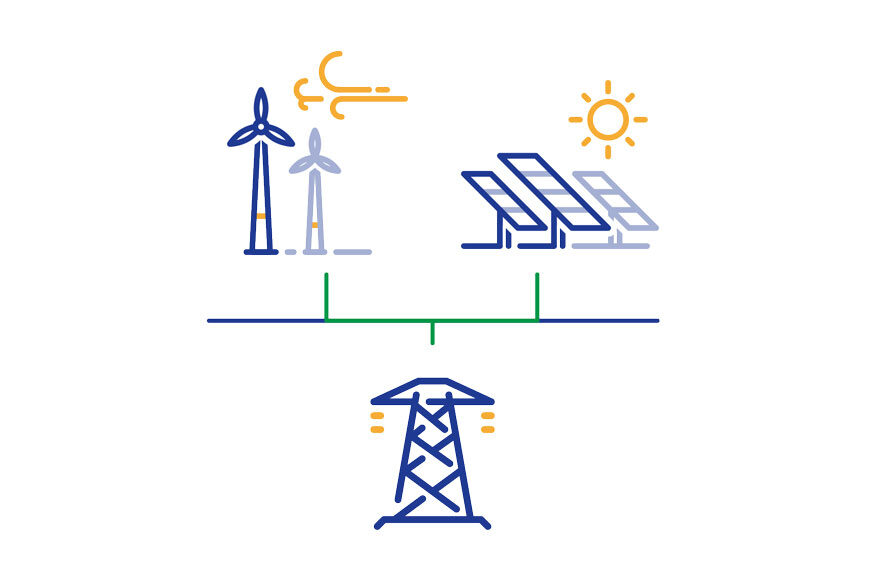Cable pooling has potential in Poland and could be a solution to our RES problems.
The number of renewable energy installations being built in Poland places us among the European leaders. Each technology used in these installations requires a connection through which the electricity produced is supplied directly to the distribution or transmission network. With the dynamic development of renewable energy sources, the need for new connections is therefore growing. However, both photovoltaics and wind power plants do not work all the time. So can the same connection be used more optimally to reduce investment and operating costs?
Wind and solar are unstable sources, dependent on weather conditions. They are therefore unable to produce electricity continuously and over a long period of time. Therefore, the connection does not use 100% of its potential during the year. Thus, its capacity is not fully utilised.
In practice, we have already seen that the electricity infrastructure is not keeping up with the pace of development of ‘green’ energy and, as a result, this is increasingly preventing the connection of new RES sources. Grid capacity is therefore slowing down the energy transition, and modernising and developing the infrastructure is costly and time-consuming.
What are the benefits of cable pooling?
The solution to this problem for now may be cable pooling. This is the sharing of an existing connection, which allows it to be used more efficiently. This is possible and, in practice, justifiable, because PV installations and those using wind power are complementary in terms of generation in the diurnal and annual cycle. In autumn and winter, as well as at night, more energy is generated from wind. By contrast, in summer and during the day, when there is a lot of sunshine, more energy is provided by photovoltaics and the wind blows less.
So by connecting a wind farm and a photovoltaic farm to the electricity grid via a single connection, we share the connection and use its capacity more efficiently. So if we have secured transmission capacity, for example for a photovoltaic farm that has already been built, cable pooling gives us the opportunity to run a wind power plant at the same location.

How do you coordinate wind and sun?
In a cable pooling system, the simultaneous occurrence of cycles with high wind and sunshine must be taken into account. The accumulated generation may at some point exceed the maximum connection capacity. Sharing a single connection for wind and PV farms therefore requires the coordination of energy demand and supply, taking into account weather forecasts and power production predictions. By adapting to weather conditions, the operation of the entire system is then limited to the capacity of the connection, temporarily switching off part of the installation or the entire generation source. Intelligent software combined with control and measurement equipment and controllers helps to manage power production in this way.
For the most efficient use of the full potential of this hybrid system, it is important to compose an appropriate ratio of installed wind farm and photovoltaic capacity. In a cable pooling system, calculations show that 50 to 100% of the wind farm’s capacity can be installed in addition to the wind farm in the form of a photovoltaic farm. It is also possible to configure an installation using cable pooling as follows: wind farm + wind farm or PV farm + PV farm. However, due to atmospheric conditions and the potential of the generating units, a mix of wind and solar sources gives the best results. It can increase the capacity of a given connection by up to more than 40%.
Krzysztof Jamróz, Vice President of the Management Board of ZPUE and Commercial Director, sees the prospects for the use of cable pooling as follows:
In my opinion, three times as many RES installations could be built using the same connections we have today, without investing in the grid. Only using energy storage and automation to limit generation to the grid.
The role of energy storage in hybrid RES installations
The sharing of a connection between a wind farm and a PV installation makes sense, as the two sources have different generation profiles. The same is true when configuring two PV installations with an energy storage facility that only stores energy from the generating equipment included in that hybrid installation. So the obvious complement to a cable pooling solution should be energy storage.
Pooling PV + storage has greater expandability, facilitates more efficient management of energy that, for technical or economic reasons, cannot be injected into the distribution or transmission grid at any given time.
Cable pooling can help the Polish electricity grid
Very importantly, the sharing of grid connections by wind and photovoltaic sources can be a recipe for the limitations of the Polish electricity grid. Interest in this solution is being shown by both RES industry representatives and power companies.
The Dutch are also facing similar problems and they, too, have high hopes of cable pooling. Meanwhile, it is worth pointing out that the potential of the Polish market in this area is much greater.
Opportunities for RES development are mainly, and in future years may be, limited by the lack of available connection capacities. For this reason, the Ministry of Climate and Environment has deemed it necessary to seek solutions that maximise the use of today’s technical and infrastructural conditions. Work on legal regulation in this regard is ongoing.

